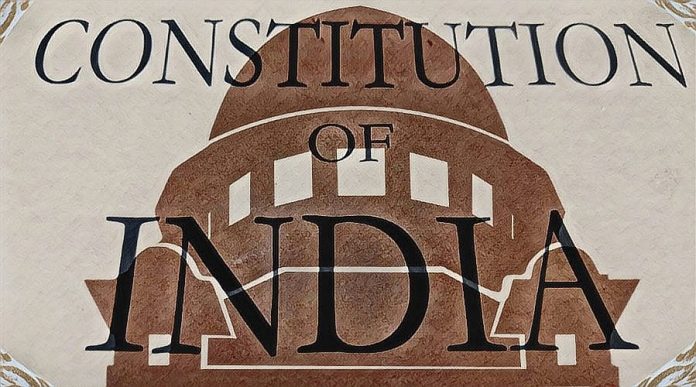This article is authored by Ashome Shandilya, from Symbiosis Law School, Noida. This article discusses Dr. B.R. Ambedkar’s contribution to Indian society.
Table of Contents
Introduction
Bhimrao Ramji Ambedkar
The father of the Indian Constitution and Messiah of the Dalits, Dr. B. R. Ambedkar was born on April 14, 1869, and this day is regarded as Ambedkar Jayanti. He was born into a Mahar household. According to the Hindu caste system, the Mahars were untouchables, and Ambedkar faced severe challenges in his early life. He was appointed as India’s law minister in 1947 and remained in office from 1947 to 1951. He was a key figure in the development of the Indian Constitution, which outlawed discrimination against untouchables and was expertly shepherded through the legislature. In 1951, he resigned from the cabinet, dissatisfied with his lack of power. In October 1956, he left Hinduism and became a Buddhist, along with nearly 200,000 other Dalits, at a ceremony in Nagpur, in despair over the Hindu doctrine’s continued support for untouchability. Ambedkar was more than just a Dalit leader or a passionate voice in social justice politics.
His achievements
He didn’t come into the world with a silver spoon in his mouth, yet he was able to make a huge impact on many people’s lives. He was honoured as a member of the Constituent Assembly and later on he was honoured as the first ‘Law Minister’ of Independent India. He had these extraordinary qualities which made him stand out from the crowd. Because of his high qualities, his profound and broad study, his huge knowledge, his wonderful mastery of the English language, his expertise in describing the topic, and his perfect patriotism, he was also honoured as the chairman of the ‘Drafting Committee’.
From the Montford Reforms (1919) through the Cabinet Mission (1946) suggestions, Dr. Ambedkar was one of the few Indian statesmen-politicians who actively participated in talks on constitutional concerns. From the twenties through the fifties of the twentieth century, he was the first and foremost leader of the depressed classes, and the struggle of the depressed classes for human rights and socio-political equality is woven around his name. As Chairman of the Drafting Committee, Dr. Ambedkar was instrumental in determining the government’s structure and the Constitution’s form. Ambedkar felt that the Constitution should be utilised as a weapon for social reform and that it would serve in bridging the class divide. He believed that this was necessary for social unity and national integration.
His role in the Indian Constitution
Dr. Ambedkar drew inspiration for the Indian Constitution from a variety of international constitutions. Since his days in the United States, Ambedkar had been a supporter of the 14th Amendment to the United States Constitution. Before being asked to lead the Drafting Committee to create the Indian Constitution, Ambedkar attempted to internationalise the issue of untouchability in the mid-1940s. For his efforts to uplift untouchables, oppressed people, labourers, and women, he became renowned as a “Dalit god.”
The round table conference
In the history of the Indian Constitution, the Round Table Conference was a turning point. Dr. Ambedkar demanded independence and hoped that the people of India would be able to address their complaints through political power, which they would receive under the ‘Swaraj’ Constitution. He argued for a government constituted by people’s representatives in order to make it a responsible one. Dr. Ambedkar did not seek to force a Constitution on the Indians, but he believed that the people’s wishes for how they should be governed should be respected.
Focusing on the Centre
Dr. Ambedkar strengthened the Centre in the Draft Constitution by giving it more powers. He faced a lot of criticism by some members of the Constituent Assembly claiming that while Dr. Ambedkar advocated for the rights and values of each individual, as well as the development of each province and hamlet; it was paradoxical on his side to strengthen the Centre. Dr. Ambedkar justified the provisions for a strong Central authority by claiming that he did so not just to “rescue the minority from the misrule of the majority,” but also because it is only the Centre that can work for a common goal and the country’s overall interests.
Offering equality
The “Fundamental Rights” specified in the Draft Constitution were valid in a court of law. Dr. Amebedkar considered “Equality of Opportunity” to be the most significant of all the rights. In terms of constitutional remedies, he describes Article 32 as the Constitution’s spirit and heart. Fundamental rights, according to him, would imply the establishment of equality and liberty in order to repair our social structure, which is rife with disparities, discrimination, and other issues that go against our fundamental rights.
Importance of Article 32
His emphasis on Article 32 reveals that he was a radical social thinker who absorbed the constitutional amendments and their implementation. He considered this the most significant Article of the Constitution, an Article that would be nullity without the Constitution.
Views on sovereignty
Dr. Ambedkar had very strong views. His concept of sovereignty and suzerainty, as well as that of the Indian States, was prophetic. His opinions on what he deemed India’s biggest blunder, Partition, were likewise frank and vocal. Dr. Bhimrao Ambedkar warned his countrymen about the dangers of partition. His criticism of the two-nation idea that gave rise to Pakistan stemmed from a great concern for and compassion for his fellow citizens, particularly the Scheduled Castes, who had lived for centuries inside the new nation’s territorial jurisdiction.
National integration
To bring Indian society together, which was divided not only by caste and class, but also by regions, religions, languages, traditions, and cultures, Dr. Ambedkar proposed single citizenship, a single judiciary, and uniformity in fundamental laws in the Draft Constitution. As a result, maintaining territorial integrity and administrative discipline required the presence of a powerful Centre. He did, however, propose in the Draft Constitution that Hindi in the ‘Devanagiri’ script be accepted as India’s national language. Dr. Ambedkar demanded the division of Punjab and Bengal, as well as the addition of territories to India when it was finally determined that India should be divided into India and Pakistan.
Ambedkar thought that political freedom would not achieve its social cohesion or national unification in the absence of economic and social justice. He promoted the eradication of caste and status prerogatives and campaigned hard for individual freedom and dignity. In his support for the unity of the country, he was vigorous. By combining the following ideas, Ambedkar hoped to attain his aims through the Indian Constitution-
- To make the country peaceful and hold the country together during good and difficult times, he wanted the Indian Constitution to be workable, flexible and strong.
- Additional protections were made for minorities and socially and educationally disadvantaged groups.
- He applied the one man, one vote and one man, one value principle. As a result, one man and one village were acknowledged as a unit under India’s Constitution.
- Eliminating untouchability and forced labour in order to realize the ideal of “one man, one value, and one man, one vote,” and placing all individuals on an equal footing with the law; ensuring equal protection of the law for all citizens, as well as freedom of profession and equal opportunity.
- Making the right genuine by including the right to constitutional remedies.
- The FR’s exclusions and qualifications shall be incorporated in defence of the President of India’s power of pre-trial detention.
His role in abolishing untouchability
Ambedkar recognized the flaws of caste society and fought for Dalits’ freedom from social discrimination, economic estrangement, and political exclusion for the rest of his life. He was a firm supporter of modernity, believing that future economic progress, democratic institutions, and republican values will serve as superstructures for ensuring the freedom of the untouchables. French rebel Rousseau has rightly said that “Man was born free, but he was in bonds everywhere,” France revolutionized his three terms justice, democracy, and fraternity in 1789. Ambedkar was strongly influenced by Rousseau’s ideas, and he resolved to fight for justice based on equality. He worked tirelessly to guarantee that those who were oppressed were given a voice in society. In addition to political justice, Dr. B.R. Ambedkar advocated for economic and social equality. The emphasis shifted to social justice rather than political justice. Individual liberty opportunities were used to show the inequities created by the caste system in the country. Untouchability is Indian society’s Achilles’ heel. Many leaders have attempted but failed, to erase the untouchable issue from our country. At Radhanagar in West Bengal’s Hooghly district, where the ‘Father of Modern India’ Raja Ram Mohan Roy was born, there are separate crematoria for Brahmans and Non-Brahmans. Since the 1970s, terminology like ‘untouchable’ and ‘Harijan’ in India have been supplanted by the term ‘Dalit.’ Dr. Bhimrao Ambedkar was the first to coin the new word. Dalit issues have now become a political rallying cry, and the people are being used as vote banks. Ambedkar deserves a lot of credit for making the Constitution prohibit the social ill of untouchability. Ambedkar’s greatest achievement was allowing India’s despondent inhabitants to experience self-sufficiency and strength. He was recognized for condensing all the miserable, untouchable castes into a single name of a single SC.
In order to investigate the request made by the National Negro Congress to the United Nations (UN) for the protection of minority rights through the UN Council, Ambedkar contacted African American intellectual and activist WEB Du Bois in July 1946. He claimed that he was a student of the problem of Black and that the position of the Untouchables in India and that of the people of Black America is so comparable that studying Negro is not only natural but also important. In one of the letters written by Du Bois to Ambedkar, he wrote he was familiar with his name and he had great sympathy with the untouchables of India.
Ambedkar was pragmatic and was making his argument for an equal country by exploiting the existing anti-discrimination speeches. In other historical occurrences, Ambedkar’s discourse finds similarities. Another social revolutionary, Jyotirao Phule, whose writings were followed by Ambedkar, could have impacted Ambedkar’s concentration on worldwide counter-discrimination. For the American abolitionists who fought the U.S. Civil War in the 1860s to eradicate the enslavement, Phule in 1873 published his first essay on the caste system- “Gulamgiri”. This essay was a tribute to the American movement against slavery. Phule wrote in the genuine hope that Indians will follow the lead of their American abolitionist brethren in freeing their lower caste brethren from the shackles of upper caste captivity.
Conclusion
Dr. Bhimrao Ramji Ambedkar was a Messiah of non-violence. As Chairman of the Constitutional Committee, he has helped our country build a sovereign, democratic, and republic based on adult franchises. The name of Baba Saheb Ambedkar will be recorded as a social justice maker in golden letters in the history of India. He was one of the sons in Indian history who may be considered a gift to India. If Mahatma Gandhi set the tone and taught morality, Baba Saheb shaped a social element that was free of exploitation. He aimed for democratic and anti-caste goals in the full sense of the word. He dedicated his entire life to helping the impoverished, oppressed, untouchables, and marginalized. Dr. Ambedkar’s contribution to Indian democracy must not be overlooked. Therefore, the world will cherish his memories and so will I.
References
- https://legislative.gov.in/sites/default/files/COI.pdf
- https://journalsofindia.com/montagu-reforms-of-1919/
- https://www.constitutionofindia.net/historical_constitutions/cabinet_mission_plan__cabinet_mission__1946__16th%20May%201946
- https://www.constitutionofindia.net/constitution_making_process/drafting_commitee
- https://constitutioncenter.org/interactive-constitution/amendment/amendment-xiv
- https://www.govinfo.gov/content/pkg/CDOC-110hdoc50/pdf/CDOC-110hdoc50.pdf
- https://www.gale.com/c/african-america-communists-and-the-national-negro-congress-1933-1947
- https://www.un.org/securitycouncil/content/current-members
- https://knowindia.gov.in/profile/fundamental-rights.php
- https://indiankanoon.org/doc/981147/
Students of Lawsikho courses regularly produce writing assignments and work on practical exercises as a part of their coursework and develop themselves in real-life practical skills.
LawSikho has created a telegram group for exchanging legal knowledge, referrals, and various opportunities. You can click on this link and join:
https://t.me/joinchat/J_0YrBa4IBSHdpuTfQO_sA
Follow us on Instagram and subscribe to our YouTube channel for more amazing legal content.










